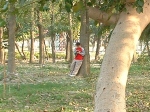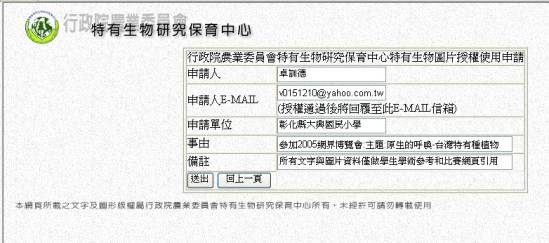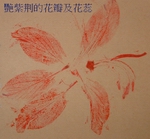|
|
For better viewing effect, please use 1024x768 as the resolution. |
|
In order for the website to run smoothly, |
|
|
please shut any restrictions for active applets. |
|
1) What information tools & technologies did you used to complete your CyberFair project?
2) In what ways did you act as "ambassadors" and spokespersons for your CyberFair project both on-line and in person All interviews are on-site interviews. Before each on-site interview, we used telephones or e-mails to get connected and decide the time of the actual on-site interview. Dr. Tseng of the Endemic Center personally gave us lessons to learn the shapes and types of leaves, making us feel as if we were university students. Mr. Pei-Chuan, a formal county councilor, now at the Huan-Shi Botanic Garden gave accounts to various kinds of plants and pot-plants – palm trees, Myrtaceae, conifer, broad-leave, etc. We learned that interests can turn into a profession. We visited Mr. Wu Chan Jay of the Ur-Ling Endemic Plants Promotional Class. The theories and interests all integrated together. After the interview, each one of us was given a pot of Taiwanese Cassia. That was great! Later, Mr. Wu came to our school. We visited the endemic plants in our campus. We discovered that the triangular maple trees and the Yu Shan Myrsinaceous died, and we were sad. Mr. Wu told us that those plants were supposed to live in mid-high altitude and not by the sea-shores which were bad conditions for them. It’s no surprise they had died. He then promised to provide more Taiwanese endemic plants suitable to be planted here, and he encouraged us to work together. He is willing to provide assistance anytime.
3) What has been the impact of your project on your community? So far Taiwan's economy development and ecology cannot yet reach a good equilibrium. Through conducting this research, the best finding is: this is not just a research, it has become a focal activity for the entire school. Our homepages stress our ideology of continuous preservation of the ecology; provide teaching materials, teaching plans and worksheets for observing plants. We can even use the wireless network to conduct teaching in our campus anytime, and we will continue to expand materials in the homepages. We waited for the winged-fruit of the acajou trees to spiral down; we expected the flat cherry to bear fruit; we wondered if the fruit of the white-rice trees really tastes like real white rice. What are the differences between the Taiwanese Sparrow Fig Trees and the Diamond-Shaped Fig Trees? Would the first one attract more birds? We care the plants; observe the plants; print the leaves; collect all kinds of seeds; try to understand the Taiwanese endemic and unique plants and their contributions to our lives. Our passions spread like fireworks. The parents have also recognized our efforts. The chairman of Tien-Wuai Farmers’ Association we interviewed praised us and commented that we know more than the students there. He said that our attitudes are positive and lovely. He also said that if all teachers of Taiwan can lead their students to care and preserve local plants like what we did, the ecology and environments would be better.
4) How did your project involve other members of your community as helpers and volunteers? The information introduced in the website is mostly provided by the team-members after their own observations and researches, but some academic data and photos of plants are from related reference books and relevant governmental ecology education websites. To respect intellectual property rights, we specify the resources of data on each homepage, and collectively listed them together on the Data Reference page. We want to serve our duties to protect intellectual rights and teach the students the right attitudes. We also used e-mails to acquire permissions for us to use the materials in the referenced websites. (The websites of the referenced materials are almost of our government’s ecological-education-related organizations)
5) Discoveries, Lessons and Surprises (Optional) To find seeds falling down and producing new offspring is not something new in our campus, which is filled with many green trees. Trees like Ceiba, Black Board Trees, Taiwanese Golden Rain Trees breed and grow with fast speeds whenever their seeds follow the winds or bird’s excretes and find suitable environments. But with another perspective, we would think that the green fields are supposed to be only the green fields, the flower gardens are supposed to be only the flower gardens. The trees are supposed to be planted in certain places, not anywhere. We would think only the original mother trees are acceptable; the new ones should not grow. But when it comes to cutting trees, some people in the community would question and take the positions to protect the trees from being cut. Until the roots of the Black Board Trees overgrew and destroyed the bricks on the pedestrian paths; and cotton batting of the cotton trees covered our whole campus and caused allergies in the campus, we didn’t realize what over-planting the trees without evaluations could do to our overall environment. Trees, flowers, grass, and plants all have influences on our daily lives. They attract insects and animals to eat or rest here. Therefore a place becomes lively and interesting. Leaves of several plants are the food for worms like the babies of butterflies, moths and other insects. Birds feed on these worms. A food chain of the biological system is formed. If we had not actually looked into these things and experienced ourselves, we would not sense the importance of the natural ecology.
|
|||||||||||||||||||||||||










